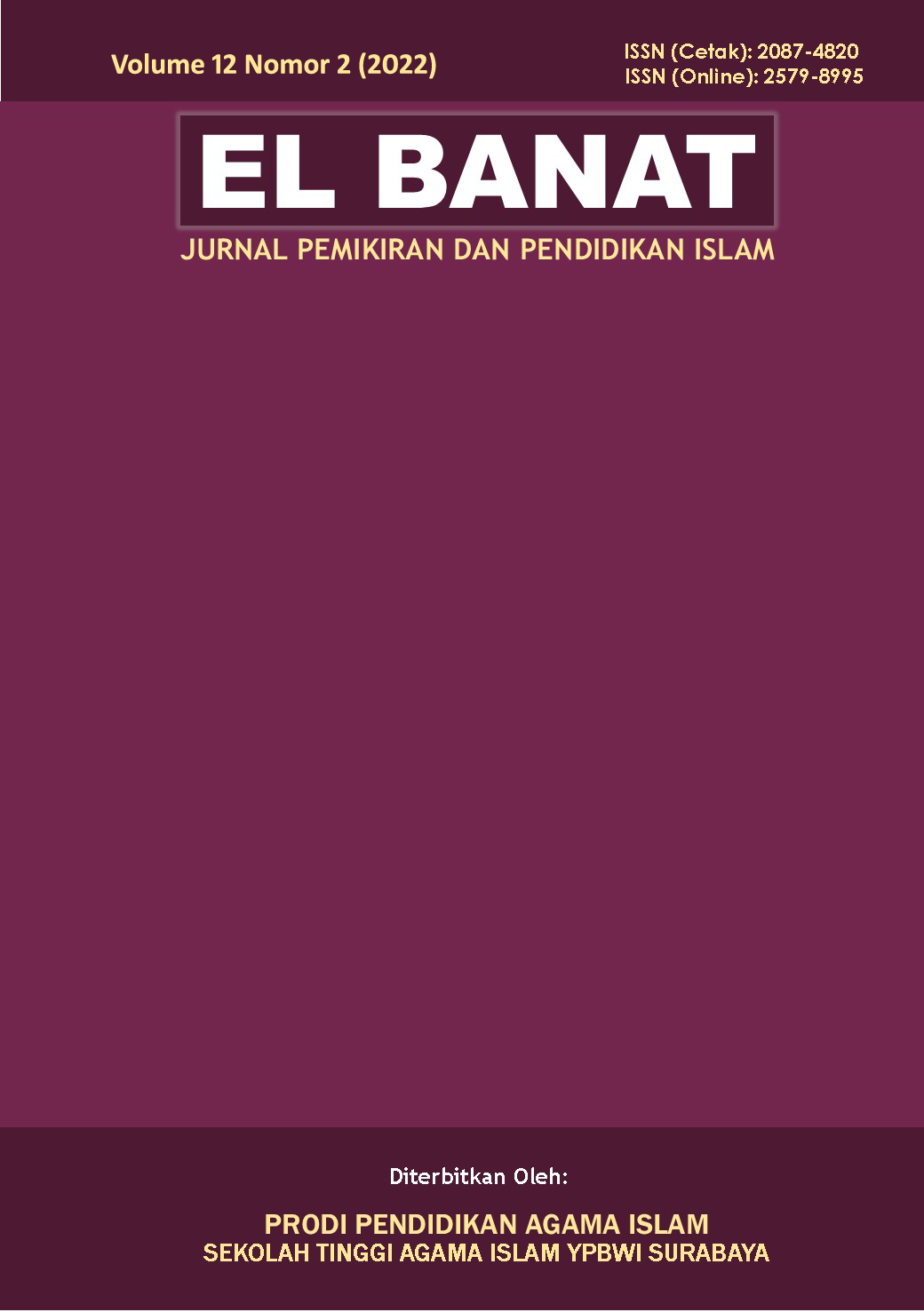Peran Khutbah Jum'at dalam Menciptakan Kerukunan Antar Umat Beragama dalam Kehidupan Bermasyarakat
DOI:
https://doi.org/10.54180/elbanat.2022.12.2.248-266Keywords:
Harmony Between Religions, Tolerance, Kutbah Jum’atAbstract
Harmony between religious communities in Indonesia will be formed if people are aware that differences in beliefs and beliefs cannot be used as an excuse to hate each other and justify excessive fanaticism. The existence of religious plurality in society is a sunnatullah that must be an introduction to mutual understanding and mutual respect between people. This study seeks to analyze the role of the Friday sermon in creating inter-religious harmony in people's lives in the Gununganyar sub-district, Surabaya City. This study uses a qualitative method, with a descriptive approach. The results of the study show that inter-religious harmony is influenced by factors: 1) Education. The majority of the Gununganyar people have received a good education, so they understand the concept of pluralism and tolerance between religions. 2) The social conditions of the residents of Gununganyar Subdistrict, Surabaya city, are safe and far from the effects of extremist thoughts and information on SARA issues. The logical consequence is that people live in peace amidst differences.
Downloads
References
Arikunto, Suharsimi. “Metode Peneltian.” Jakarta: Rineka Cipta 173 (2010).
Aziz, Moh Ali. “Bersiul Di Tengah Badai: Khutbah Penyemangat Hidup.” Surabaya, 2015.
———. Ilmu Dakwah: Edisi Revisi. Prenada Media, 2019.
Budiwanti, Erni. “Mempertahankan Identitas Dan Toleransi Antaragama: Minoritas Muslim Di Lombok Dan Bali.” Konflik Komunal di Indonesia saat ini, Series INIS
XLI, Jakarta: INIS (2003).
dan Huberman, Miles. “Analisis Data Kualitatif.” Jakarta: UI Pres, TT (1992).
Danurahman1a, Jeni, Danang Prasetyo2b, and Hendra Hermawan3c. “Kajian Pendidikan Multikultural Di Era Digital” (2021).
Devi, Dwi Ananta. Toleransi Beragama. Alprin, 2020.
Masduki, Hendri. “Pluralisme Dan Multikulturalisme Dalam Perspektif Kerukunan Antar Umat Beragama (Telaah Dan Urgensinya Dalam Sistem Berbangsa Dan Bernegara).” DIMENSI-Journal of Sociology 9, no. 1 (2016).
Mathar, M Qasim. “Sejarah, Teologi Dan Etika Agama-Agama.” Yogyakarta: Pustaka Pelajar (2005).
Merry, Sally Engle. “Legal Pluralism and Legal Culture: Mapping the Terrain.” In Legal Pluralism and Development: Scholars and Practitioners in Dialogue, 66–82. Cambridge University Press, 2012.
Mibtadin, Mibtadin, and Fathol Hedi. “Masjid, Khutbah Jum’at, Dan Konstruksi Realitas Keagamaan Di Ruang Publik: Studi Tentang Materi Khutbah Jum’at Di Masjid Masjid Kota Surakarta.” Jurnal Ilmu Dakwah 40, no. 1 (2020): 40–53.
Najmina, Nana. “Pendidikan Multikultural Dalam Membentuk Karakter Bangsa Indonesia.” JUPIIS: Jurnal Pendidikan Ilmu-Ilmu Sosial 10, no. 1 (2018): 52–56. Qu?b, Sayyid. Tafsir Fi Zhilalil Qur’an. Gema Insani, 2000.
Rahman, Mohamad Taufiq, and Paelani Setia. “Pluralism in the Light of Islam.” Jurnal Iman Dan Spiritualitas 1, no. 2 (2021): 204–210.
Rasyid, Sulaiman. “Fiqh Islam, Cet. 17.” Bandung: PT Sinar Baru 19960 (1996).
Rusydi, Ibnu, and Siti Zolehah. “Makna Kerukunan Antar Umat Beragama Dalam Konteks Keislaman Dan Keindonesian.” Al-Afkar, Journal For Islamic Studies
(2018): 170–181.
Sa’diyah, Rika. “The Influence of Religious Motivation and Students Learning Outcomes in Islamic Religious Education Towards Students Tolerance Attitude.” TARBIYA:
Journal of Education in Muslim Society 2, no. 1 (2015): 70–82.
Saliyo, Saliyo. “Pengaruh Religiusitas Jamaah Masjid Az-Zuhud Petanahan Kebumen Terhadap Perilaku Toleransi Beragama Dengan Kepribadian Yang Dimilikinya.”
INFERENSI: Jurnal Penelitian Sosial Keagamaan 12, no. 1 (2018): 65–84.
Sukayat, Tata. “Quantum Dakwah.” Jakarta: Rineka Cipta (2009).
Suryana, Toto. “Konsep Dan Aktualisasi Kerukunan Antar Umat Beragama.” Jurnal Pendidikan Agama Islam 9, no. 2 (2011): 127–136.
Yunan, Nasution. “Islam Dan Problema-Problema Kemasyarakatan.” Cet. I. Jakarta: PT. Bulan Bintang, 1988.





